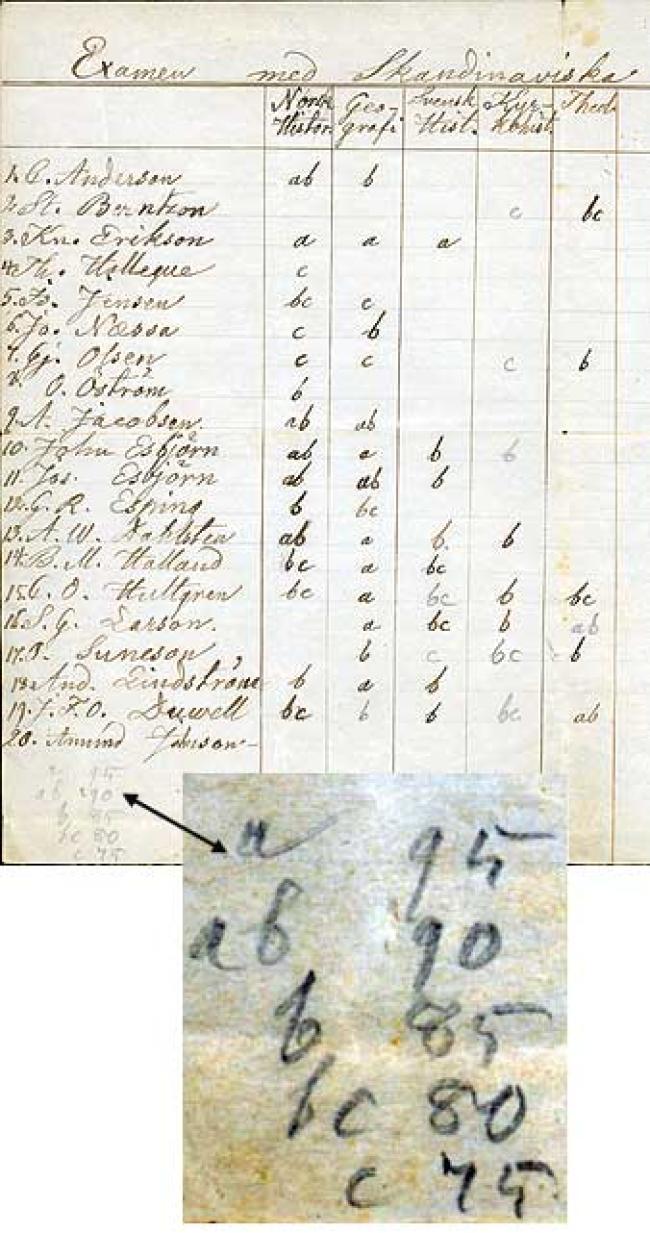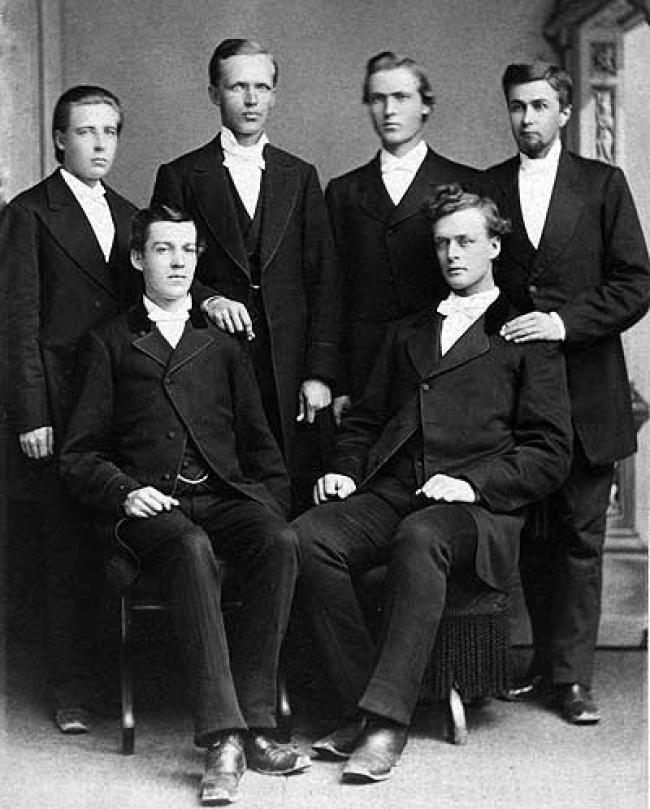Was Augustana the first school to use letter grades?
(This story was written in celebration of Augustana's sesquicentennial in 2010.)

Look carefully at the document reproduced at right. It was created by Lars Paul Esbjörn, the first president of the Augustana Seminary, most likely at the end of the school’s first academic year (1860-1861). In this chart, Esbjörn uses the designations a, ab, b, bc, and c to record the performance of twenty Scandinavian students in five subjects of study: Norwegian history, geography, Swedish history, church history, and theology. A scale is written in pencil in the bottom left-hand corner of the chart.
Why is this document so important? It may be the oldest evidence extant in the United States of the evaluation of students using letter grades.
The story that Augustana pioneered the use of letter grades in this country has circulated before. However, this particular Augustana “first” tends not to receive much attention, perhaps because it cannot be firmly proven.
But a 1949 article in the Observer found the possibility compelling enough to declare it with confidence. “Horrible Truth Revealed,” the headline reads. “A, B, C Grading System Began at this . . . Institution.”
The article, which was written by junior Bernard Wickstrom, tells the story of then-President Conrad Bergendoff’s conversation in 1939 with Sir William Craigie and James R. Hulbert, the editors of A Dictionary of American English on Historical Principles (1938-1944). They informed Bergendoff that they could find no evidence of any school’s having employed letter grades earlier than Augustana.
In Craigie and Hulbert’s published dictionary, their etymological note for the letter A, as used to denote the highest possible mark for a piece of schoolwork, reads as follows:
The system of grading by means of the letters A, B, C, etc., has been used in various institutions (e.g., Augustana College, Rock Island, Ill.) since 1883.
Although the entry provides no explanation for its choice of date, the year 1883 most likely comes from the Augustana College and Theological Seminary catalog of 1883-1884. Here, Augustana published for the first time an official policy of evaluating students with letter grades. The catalog explains that students will be assessed at the end of each academic year with respect to their knowledge and ability, diligence, deportment, and attendance. It continues:
The following expressions are employed as testimonies in respect to 1:0) Knowledge and Ability: Superior (A), Excellent (a), Laudable (AB), Commendable (ab), Good (B), Admissible (b), Inadmissible (C); 2:0) Diligence: Very Good (A), Good (B), Ordinary (b), Censurable (C); 3:0) Deportment: Very Good (A), Good (B), Exceptionable (C).

Apparently, this schema was the oldest officially enacted letter-grading system Craigie and Hulbert found in the course of their research, and, because of this, they highlighted Augustana in their entry on letter grades. However, as the wording of the entry demonstrates, they declined to claim that Augustana was the first school to use letter grades, presumably for lack of concrete proof.
A later version of the dictionary, Mitford M. Mathews’s A Dictionary of Americanisms on Historical Principles (1951), expands upon the link between Augustana and the earliest use of letter grades:
The faculty minutes of Augustana College, Rock Island, Illinois, for June, 1877, refer to the adoption there of a marking system using the letters A, a, AB, ab, B. Augustana was founded by graduates of the Swedish universities of Upsala and Lund. In at least some of the elementary schools in Sweden letters were used as grade marks certainly as early as 1871, and the system adopted at Augustana apparently reflects earlier Swedish usage. The use of letters in this way at other institutions has not been investigated.
Indeed, the faculty minutes of June 1877 include a grading chart quite similar to Esbjörn’s of 1861, except with more subjects of study and slightly different letter combinations, including capital letters as well as lowercase. Portions of the chart, as well as much of the surrounding text, have been eaten away — most likely by insects or mice—so it is impossible to determine its complete context. But the text that remains, meticulously handwritten in Swedish, suggests that the situation was not quite as the 1951 Dictionary interprets it. Specifically, the faculty minutes of June 1877 do not refer to the adoption of letter grades but, instead, describe letter grades as a system already in existence. In other words, Augustana may well have been using letter grades continuously between 1860 and 1877.

The gap between Esbjörn’s chart of 1861 and the faculty minutes of June 1877 remains a mystery. Former Augustana President Conrad Bergendoff, in Augustana . . . A Profession of Faith (1969), the definitive history of the college’s early years, comments on Esbjorn’s use of letter grades, but he does not say whether the system ever fell out of use in that first decade. Clearly, Craigie and Hulbert and Mathews, in their dictionaries, cited the dates 1883 and 1877 because of the supporting written evidence. But letter grading may well have been, in effect, the “official” Augustana marking system throughout its earliest years.
What none of this answers, of course, is whether Augustana was truly the first school in the United States to use letter grades: Only a thorough comparison with other schools in existence in 1860 would answer that question. What we do know is that Augustana was, if nothing else, among the earliest adopters of letter grades.
Mitford Mathews’s dictionary links letter grades back to Sweden, where, he writes, they were used “as early as 1871.” Bergendoff, on the other hand, implies the system was used in Sweden by the 1850s or earlier: he notes that Esbjorn drew on an existing Swedish marking system when he began evaluating students with letter grades in 1860.
Either way, it would make sense that the first school in the Augustana Synod — a Swedish-Lutheran church body — might have introduced letter grades to the United States. That would make this now-ubiquitous marking system yet another legacy of Augustana’s Swedish heritage.
— Stefanie Bluemle ‘02
Reference Librarian
(Thanks to Christina Johansson for her assistance in translating the faculty minutes.)
